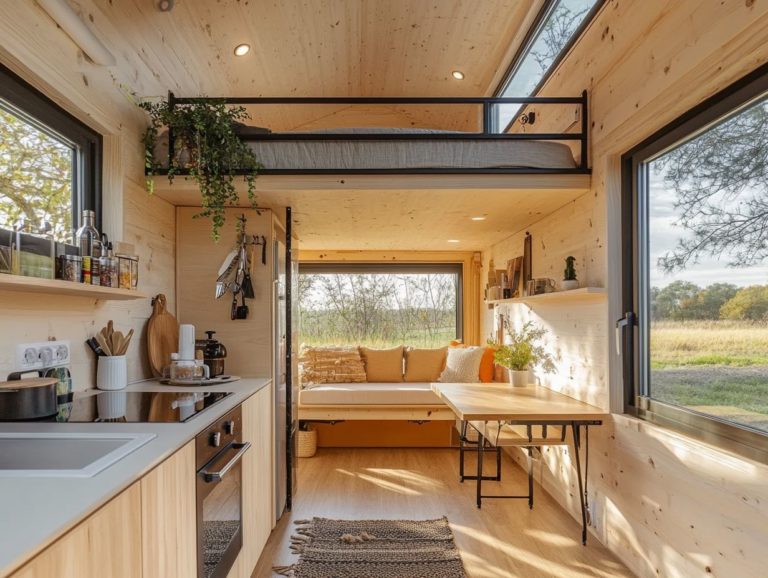9 Essential Tools for Tiny House Maintenance
Maintaining a tiny house demands a unique collection of tools that enhance both ease and efficiency in your tasks.
Whether you’re managing routine upkeep or diving into surprise repairs, having the right equipment at your fingertips is essential. Get ready to discover nine must-have tools that every tiny house owner needs to succeed!
Delve into maintenance frequency, common tasks, budget-friendly strategies, and discover how meticulous upkeep can significantly extend your tiny home s lifespan. Let’s gear up for your next project!
Contents [hide]
- Key Takeaways:
- 1. Multi-Functional Tools
- 2. Ladder or Step Stool
- 3. Basic Hand Tools
- 4. Power Drill
- 5. Caulking Gun
- 6. Paint Brushes and Rollers
- 7. Pressure Washer
- 8. Wet/Dry Vacuum
- 9. Fire Extinguisher
- How Often Should You Perform Maintenance on a Tiny House and Utilize Your Homeowners Toolkit?
- Frequently Asked Questions about Home Repairs and Maintenance
- What are 9 essential tools for tiny house maintenance and DIY enthusiasts?
- Why are essential tools important for tiny house maintenance?
- Can I start with a basic toolkit instead of buying all 9 tools at once?
- Can I substitute some tools or are all of them necessary?
- Where can I buy these essential tools for tiny house maintenance?
- Do I need experience to use these essential tools for maintenance?
Key Takeaways:
- Invest in tools that do multiple jobs to save space and money.
- Keep a ladder or step stool on hand for easy access to high areas.
- A basic toolkit, power drill, and caulking gun are essential for small repairs and projects.
1. Multi-Functional Tools
In the realm of home repair, multi-functional tools are essential for homeowners looking to elevate their toolkit for various Do It Yourself (DIY) projects. These tools combine many functions into one, making them critical for everything from minor repairs to substantial home improvement tasks.
Imagine using sleek utility knives that slice through materials with ease or screwdrivers featuring interchangeable heads that handle a variety of fasteners. Efficiency and convenience are truly at the forefront of modern tool design.
Consider adjustable wrenches that enhance your versatility, allowing for quick adjustments to accommodate different sizes of nuts and bolts. By incorporating these all-in-one solutions, you can significantly declutter your toolbox, ensuring you always have exactly what you need for any job without the hassle of hunting down multiple single-function tools.
2. Ladder or Step Stool
A ladder or step stool is a critical asset for every homeowner, granting you the height needed to reach those elusive spots during maintenance and repair tasks, particularly when using a level for accurate measurements.
With various options at your disposal like extension ladders for outdoor projects, versatile multi-purpose ladders that adapt to different configurations, and compact step stools perfect for indoor chores there’s a tailored tool for every undertaking.
It’s also essential to keep an eye on crucial safety features, such as non-slip steps and stabilizing feet, which significantly enhance stability and help prevent accidents while you re painting ceilings or swapping out light fixtures. These tools are pivotal in ensuring both efficiency and safety throughout your home improvement endeavors.
They enable you to confidently tackle everything from minor d cor updates to more intricate repairs.
3. Basic Hand Tools
A well-stocked homeowner’s toolkit is essential and should certainly include basic hand tools such as a claw hammer, various screwdrivers, pliers, and a utility knife. These fundamental tools are your allies for tackling everyday home repairs and maintenance tasks.
With these simple yet critical tools, you can confidently address a variety of issues, from fixing squeaky doors and assembling furniture to making minor electrical adjustments. For example, a claw hammer isn’t just for driving nails into walls; it’s also your go-to for pulling them out when the need arises.
A set of screwdrivers is invaluable, ensuring you re ready for any type of fastener you encounter around the house.
- Pliers offer a strong grip for tightening, twisting, or bending wires.
- A utility knife is ideal for making clean cuts on materials like cardboard or rope, and pairing it with measuring tape ensures precision.
In essence, having these tools at your disposal enables you to take on DIY projects with confidence, ultimately saving you both time and money in the long run.
4. Power Drill
A power drill is a must-have tool for homeowners. It offers convenience and power for tasks like assembling furniture and drilling holes in DIY projects.
These versatile tools come in various types, including cordless drills and electric screwdrivers, each tailored for specific applications. Cordless drills provide the freedom to move without being tied to an outlet, making them perfect for outdoor tasks or areas where power sources are limited.
Electric screwdrivers excel at lighter jobs, like fastening screws in cabinetry or securing lightweight fixtures. By understanding the unique features of each type, you can select the right tool for your repair and improvement projects, ensuring efficiency and ease.
5. Caulking Gun
A caulking gun is a critical tool for any homeowner. It helps you apply sealants and adhesives easily during home repairs and maintenance tasks, playing a vital role in preventing leaks and drafts.
With a caulking gun, you can tackle projects confidently and efficiently! From sealing gaps around windows and doors to caulking kitchen and bathroom fixtures, using this tool effectively helps ensure that moisture stays where it belongs.
This guards against potential water damage and mold growth. To achieve the best results, select the right type of caulk silicone for high-humidity areas like bathrooms and kitchens, acrylic for indoor projects, and polyurethane for outdoor applications.
By maintaining a steady hand and applying even pressure during use, you can create cleaner lines and achieve more efficient sealing.
6. Paint Brushes and Rollers
Paint brushes and rollers are essential tools for anyone diving into home improvements and DIY projects. They enable you to effortlessly apply paint and finishes for a fresh, vibrant look.
Knowing about different paint tools will improve your results. For instance, flat brushes are fantastic for broad strokes and ensuring even coverage on larger surfaces, while angled brushes excel at cutting in around edges and handling tight corners with finesse.
Rollers come in a range of thicknesses of fabric, which are crucial for achieving a smooth finish on walls and ceilings. A longer thickness is perfect for textured surfaces, while a shorter one is best suited for smoother finishes.
To ensure a professional touch, pair the right tools with proper techniques like keeping a damp edge while painting and applying paint in thin layers to significantly enhance the quality of your DIY painting project.
7. Pressure Washer
A pressure washer is an invaluable tool for maintaining the exterior of your home. It effortlessly removes dirt, grime, and mildew from surfaces like patios, driveways, and siding.
Using high-pressure water spray, this versatile device revitalizes your outdoor spaces and helps prevent long-term damage caused by buildup. Regular cleaning with a pressure washer can extend the lifespan of your surfaces and minimize the need for costly repairs down the line.
Choose the right nozzle for the best results and adjust the pressure settings accordingly. Don t forget to wear protective gear and secure nearby windows and plants to enhance both safety and effectiveness during the cleaning process.
8. Wet/Dry Vacuum
A wet/dry vacuum is a must-have for every homeowner! It’s designed to handle both liquid spills and dry debris, making it your go-to companion for home repairs and maintenance projects.
With powerful suction and an array of attachments, this appliance provides practical solutions for various situations from unclogging gutters to tackling workshop dust. Using a wet/dry vacuum can significantly elevate your cleaning game during large events or in high-traffic areas, efficiently managing messes in record time.
When you’re in the market for the right model, think about factors like tank size, motor power, and how you plan to use it. Different models boast unique features such as advanced filters, tank drain valves, and specialized nozzles, all of which can greatly enhance your cleaning experience.
9. Fire Extinguisher
A fire extinguisher is an important safety tool for every homeowner. It offers peace of mind and immediate response capabilities during emergencies related to home maintenance and repairs, ensuring safety while using power tools like a circular saw.
Choosing the right type of extinguisher is crucial for effectively tackling different fire hazards. For instance, a Class A extinguisher is for putting out fires caused by wood or paper, while a Class B extinguisher is essential for flammable liquids like grease and gasoline. A Class C extinguisher is also important for electrical fires, ensuring you’re well-prepared for a range of potential incidents.
Placement is significant; position extinguishers in easily accessible spots, ideally near the kitchen or bedrooms. Regular maintenance is vital. Conduct monthly checks and arrange for annual servicing to bolster safety, making your fire extinguisher a cornerstone of your home s safety strategy. Don t forget to have essential tools on hand, like a flashlight for emergencies, to further enhance your preparedness.
How Often Should You Perform Maintenance on a Tiny House and Utilize Your Homeowners Toolkit?
Regular maintenance of your tiny house is essential for prolonging its lifespan and ensuring a safe, comfortable living environment. Establish a maintenance schedule that covers various tasks throughout the year.
This approach helps you avoid costly repairs and makes your space more efficient. As the seasons change, check your insulation and seals in the fall to safeguard warmth during winter. Spring is the perfect time to inspect your roofing and gutters for debris or damage, ensuring you have the right measuring tape to assess any changes needed.
Dive into DIY projects like building outdoor storage solutions or creating vertical gardens. Each season brings its own responsibilities, contributing to the cozy and sustainable lifestyle that tiny house enthusiasts treasure. To better understand these responsibilities, explore the maintenance needs of a tiny house.
What Are the Most Common Maintenance Tasks for a Tiny House?
Common maintenance tasks for your tiny house include checking for leaks, maintaining the roof, inspecting plumbing, and ensuring proper ventilation. These tasks are essential for preserving both the structure and comfort of your home.
Regularly scheduling these tasks fosters a healthy living environment and helps you avoid costly repairs down the line. Keeping your roof in top shape can prevent water damage and mold growth, which can compromise safety and air quality. Routine plumbing inspections allow you to catch minor issues like slow drains or small leaks before they turn into major headaches.
Proper ventilation is vital to prevent humidity buildup, which can lead to condensation and negatively affect your home’s structure. By adopting a proactive approach to these maintenance tasks, you enhance the longevity and livability of your tiny home.
How Can These Tools Help with Maintenance?
The right tools are essential for maintaining your tiny house. They enable you to efficiently tackle repairs and maintenance tasks, ensuring your home remains in excellent condition.
Your toolkit can include basic hand tools like screwdrivers and wrenches, as well as specialized equipment such as a multi-tool a handy device that combines several tools into one, like a knife, scissors, and screwdriver or a compact drill set. A quality level ensures that your shelves are perfectly straight. A solid set of pliers assists with various tightening and gripping tasks.
If you are ambitious enough to undertake more complex projects, a portable workbench provides the stability required for precise craftsmanship. A reliable ladder allows you to safely access hard-to-reach areas, enabling thorough maintenance without the risk of accidents.
With all of these quality tools at your disposal, routine upkeep transforms into a manageable and even enjoyable process, helping you engage in home improvements more efficiently.
What Are the Benefits of Regular Maintenance for a Tiny House?
Regular maintenance for your tiny house brings a wealth of advantages, including enhanced safety, improved efficiency, and an extended lifespan for your home. You’ll be amazed at how much a little maintenance can enhance your tiny house!
Staying on top of upkeep ensures energy efficiency, which can lead to significant reductions in your utility bills over time. By maintaining your appliances and systems, you can avoid costly repairs that often result from neglect, ultimately saving you money in the long run. A well-kept property not only retains its value but also attracts future buyers or renters.
This proactive approach transforms your small space into a more comfortable living environment while fostering a sustainable lifestyle, showcasing your commitment to stewardship over your home and your dedication to DIY projects.
What Are Some Tips for Maintaining a Tiny House on a Budget?
Maintaining a tiny house on a budget is not just possible; it s a fun opportunity to be creative! With the right approach and a sprinkle of resourcefulness, you can keep your home in excellent condition without overspending by employing strategic planning.
Embracing DIY repair techniques allows you to address minor issues before they balloon into expensive headaches. Explore local resources for materials think community barter networks, thrift shops, or habitat restorations. These can be treasure troves for budget-friendly supplies you need.
By prioritizing maintenance tasks, focus on the most pressing needs, like sealing drafts or fixing leaks. This not only enhances your home s efficiency but also boosts comfort without draining your wallet. With a dash of creativity and a bit of effort, you can cultivate a cozy, functional living space that truly reflects your personal style.
How Can Proper Maintenance Extend the Lifespan of a Tiny House?
Proper maintenance is essential for extending the lifespan of your tiny house, as it prevents deterioration and ensures that all systems operate at peak performance. Peak performance means that everything works as efficiently as possible, saving you both time and money.
Regular inspections are critical. Check for water leaks and ensure your electrical systems are in good shape to avoid costly repairs. For instance, a simple faulty pipe that goes unnoticed could lead to water damage, compromising the structural integrity of your home and inviting mold growth.
This isn’t just an expensive fix; it can also pose health risks for you and your loved ones. Routine cleaning of the exterior and applying protective coatings can shield your home from weather-related wear and tear, ensuring it remains a safe, comfortable oasis for years to come.
Frequently Asked Questions about Home Repairs and Maintenance
What are 9 essential tools for tiny house maintenance and DIY enthusiasts?
The 9 essential tools for tiny house maintenance are a hammer, screwdriver set, pliers, adjustable wrench, measuring tape, level, utility knife, ladder, and caulking gun. These tools ensure you have the right equipment for effective home repairs.
Start gathering your tools today to make your tiny house shine!
Why are essential tools important for tiny house maintenance?
Having essential tools on hand makes it easier to fix and maintain your tiny house. This saves you time and money, making them vital for every homeowner.
Can I start with a basic toolkit instead of buying all 9 tools at once?
You can begin with basic tools and gradually add more specialized ones as you need them. This way, you’ll build a complete set of tools for your home.
Can I substitute some tools or are all of them necessary?
It’s best not to substitute these tools. They are designed for specific maintenance tasks in a tiny house, and having the right tools is crucial for effective outcomes.
Where can I buy these essential tools for tiny house maintenance?
You can find these tools at hardware stores, home improvement centers, and online retailers. They are accessible for all homeowners.
Do I need experience to use these essential tools for maintenance?
Some tasks may need experience, but many basic maintenance jobs can be done easily with these essential tools. Just follow some simple instructions and you ll be on your way!




